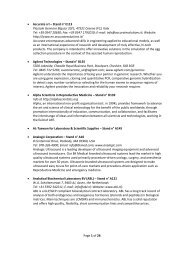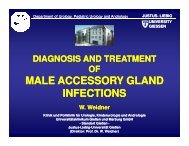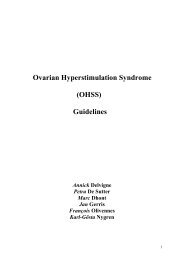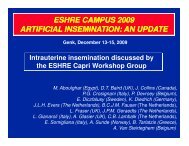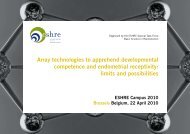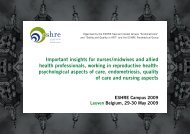here - eshre
here - eshre
here - eshre
- No tags were found...
Create successful ePaper yourself
Turn your PDF publications into a flip-book with our unique Google optimized e-Paper software.
Men need fertility preservation tooChemotherapy may have a similarly adverse effect onsemen parameters in men as on ovarian function inwomen. Roelof Menkveld, the Past Co-ordinator of theSIG Androogy, confirmed that both sperm functionand DNA status may each be affected, with aresulting increased risk of azoospermia and poorsperm function. Fertility preservation, he said, aheadof cancer treatment will provide an opportunity forlater conception through IUI or ART. Citing a study of2005 (Agarawal and Allamaneni), Menkveld reportedthat sperm volume, count and motility in 205adolescent cancer patients were almost half that ofcontrols, and in patients with testicular cancer andleukaemia sperm concentrations were considerablylower. The most negative effect of chemotherapyappears to be on DNA integrity. In 2007 Schmidt etal showed that before treatment 91% of a studygroup had fat<strong>here</strong>d a child, which fell to 67% aftertreatment.However, while semen cryopreservation will providea means of preserving fertility, cryoprservation itselfwill reduce sperm motility and reduce fertilisationpotential.So far, he added, the 'usefulness' of cryopreservedsemen seems limited, with studies suggesting anuptake of around 5% following cancer treatment.Menkveld's own experience, from a pool of 64 cancerpatients, has so far found an uptake rate of only4.7% - although he and others have emphasised thatthe storage of sperm gives hope and confidence tomany young men that they do have a future after theircancer treatment.Volume (ml)Count (106/ml)Motility (%)Morphology(% normal)Before freezingMean (SD) Range2.8 ± 1.5 0.5 - 7.039 ± 29 0.1 - 10045 ± 11 0 - 605.8 ± 5.2 1.0 - 18After freezingMean (SD) Range--18 ± 13 4.5 - 40.023 ± 12 0 - 40.0--The effect of cryopreservation on semen parameters in 64cancer patients (Menkveld unpublished data).does seem to be a degree of stigmatisation about infertilityfor men which women don’t feel. ‘Women with fertilityproblems tend to be pitied,’ said Wischman citing a 1992study of Nachtigall et al, ‘w<strong>here</strong>as men are more likely toencounter insulting slurs on their manhood.’ Even the basicsemen analysis, he added, has sexual connotations in itsdemand for a semen sample.Despite the gender differences, Wischman concluded thatmen do indeed suffer on account of their infertility, but feelthey have fewer outlets than women to express theirfeelings - and of course counselling should recognise thesedifferences and provide its information and support in away which acknowledges the differences. He also showedthat men felt a need to be strong for their partners, andthus tend to hide their own feelings.This same gender gap is apparent in how men react toparenthood following treatment by donor insemination -what Petra Thorn, a former co-ordinator of the SIGPsychology & Counselling, called a ‘shift from biologicalto social fatherhood’. She proposed that only biologicalfatherhood is considered by many men as ‘real’fatherhood, and that men considering DI or adoption mayoften need many months to accept the treatment as arealistic alternative. And even as the child grows t<strong>here</strong> maywell remain tensions for the man - between his own role asa ‘social’ parent and his partner’s as the ‘biological’ parent.Similar tensions might be played out over disclosure anddonor identity. Again, said Petra, these are tensions anddifficulties which counselling can help explore and resolve.Thus, if the proper place of a man in the fertility clinicrequires full investigation and the sensitive support ofcounselling, how important are the conventional tests ofbasic semen analysis? Anthony Hirsh, an andrologist fromLondon, left no doubt that sperm dysfunction represents‘the largest defined cause of human subfertility’. But t<strong>here</strong>was also evidence that many of the studies on which thelatest WHO reference values for semen analysis were basedwere in fact methodologically unreliable - with inconsistentstandards evident in laboratory methods, statisticalmethods and results.And, as Sheena Lewis made clear in her presentation(and as she explains in more detail on page 27) semenanalysis itself has limited diagnostic value for maleinfertility - and is not predictive for ART outcome.Techniques such as IMSI or tests for birefringence havesought to provide a non-invasive dimension beyondconventional semen analysis, while the latest sperm DNAtests now seem able to improve ART results in both malefactor and unexplained infertility.Of course, bubbling beneath the surface of this meetingwas the fact that ICSI can now - according to AnthonyHirsh - ‘treat’ 98% of all cases of male factor infertility,though not always successfully. And the long-term followupstudies of ICSI babies performed at the Free UniversityHospital in Brussels are accumulating ‘reassuring data’ inthe overall health, gonadal function and psychologicaldevelopment of the children born. So the debate inIstanbul, that treatment should be directed at the man andnot just his sperm, will not be easily won. But <strong>here</strong> was astrong case in favour, that infertility may mean to a manmore than just a sperm deficiency, and that thepsychological implications, as well as the physiological,require a broad interpretation.Simon BrownFocus on ReproductionFocus on Reproduction January 2012 15





